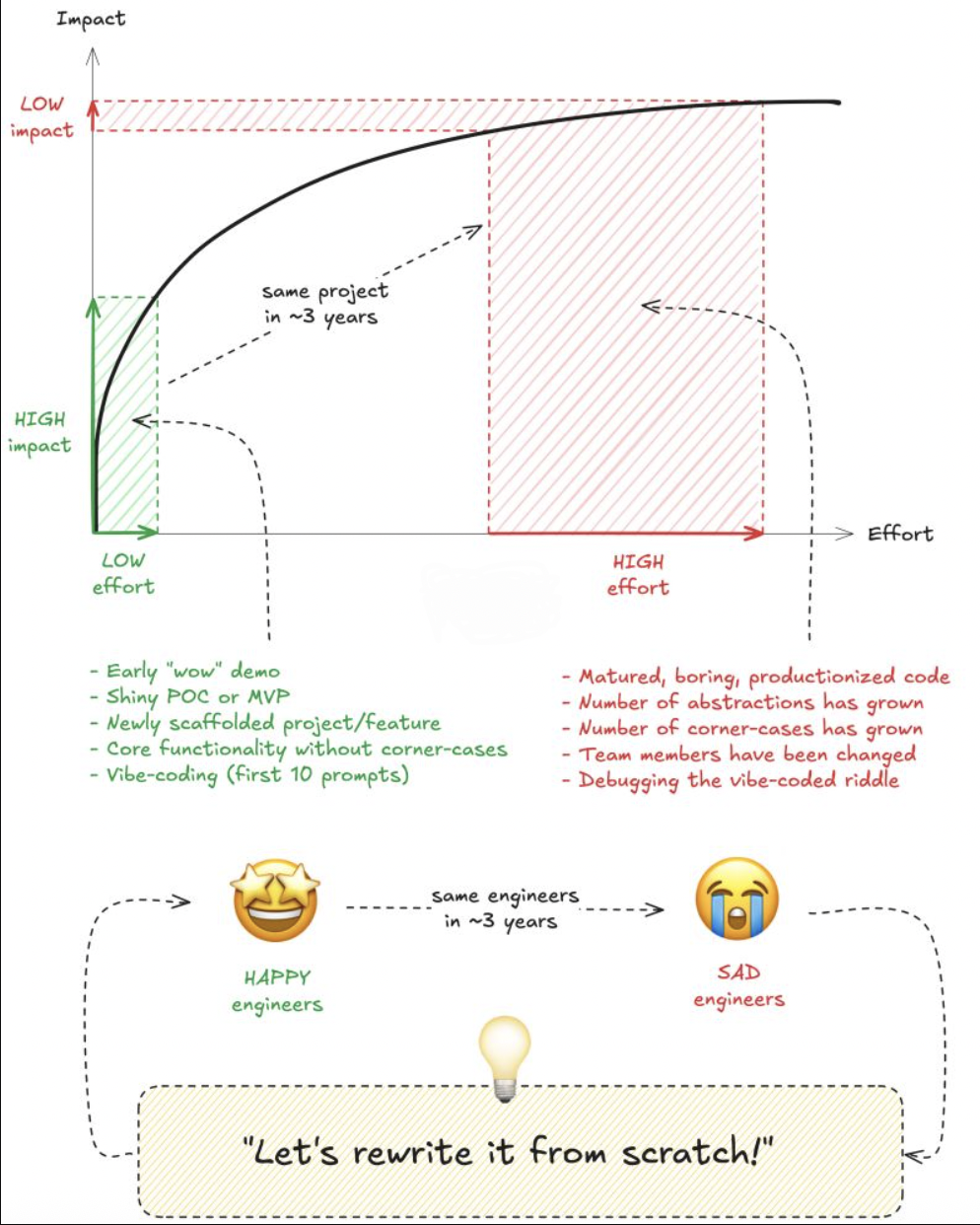Every engineer has been here: staring at the same project they helped launch, now bloated and twisted, and muttering the infamous words — “Let’s rewrite it from scratch.”
But why does this keep happening?
Let’s walk through the typical lifecycle of a software project using the clever chart above that maps Impact against Effort over time.
🚀 Phase 1: Low Effort, High Impact (The Honeymoon)
In the early stages of a project:
- You build a shiny POC or MVP
- It's fast, simple, and does just enough to impress
- The code is new, clean, and full of possibilities
- There are few corner cases to worry about
- You're in the magical state of “vibe-coding” — everything flows
Impact is high, and effort is low.
Everyone’s thrilled. 🚀
Typical Outcomes:
- Demos wow stakeholders
- Engineers are HAPPY 😄
- Progress feels rapid and energizing
😴 Phase 2: The Plateau (Reality Hits)
Fast forward ~3 years…
The same project now:
- Has matured and been productized
- Is filled with abstractions built to handle “just one more use-case”
- Has accumulated technical debt
- Has seen multiple handoffs between team members
- Requires debugging of code that was written with yesterday’s “vibes” but today’s pressure
The result?
🔧 High effort for minimal incremental impact
😩 Engineers are now SAD.
Common Pain Points:
- Fixing regressions in old features
- Handling edge cases that didn't matter during MVP
- Fear of touching legacy code
- Confusion around abstractions added over time
💡 Phase 3: The Rewrite Temptation
This is where that little lightbulb appears:
“We should just rewrite this from scratch!”
It’s tempting — and often reasonable — to think a clean slate will be faster. After all, you’re smarter now, right? You’ve learned from the past. You can avoid all those mistakes...
But if you start over, where do you end up?
👉 Right back at Phase 1.
The cycle repeats.
🎢 The Rewrite Cycle: A Developer’s Groundhog Day
So why does this cycle feel inevitable?
Because:
- Software complexity increases over time
- Business needs evolve, but the architecture doesn’t always keep up
- People change — and undocumented assumptions get lost
- Perception of progress is skewed: early work always “feels” faster and more rewarding
✅ Breaking the Cycle: Some Thoughts
While rewrites may be needed in rare cases, here’s how to avoid falling into the loop every 3 years:
Invest in maintainability early
Clean code, docs, and readable abstractions pay off.Accept complexity as a cost of success
More users = more features = more edge cases.Refactor gradually
Avoid big bang rewrites. Focus on incremental improvements.Improve onboarding and knowledge sharing
The better new team members understand the history, the less tempting rewrites become.Celebrate boring, stable code
If the code is dull and just works — that's a huge win.

🎯 Final Thoughts
This chart is a hilarious but painfully accurate representation of what so many of us experience: the shift from excited innovation to tired maintenance.
But before you light the fuse on a rewrite, ask yourself:
Is this just the nostalgia of the “early days” talking?
Sometimes, it’s better to build on top of what exists — not start over.
Because the only thing more exhausting than maintaining legacy code...
...is creating new legacy code.

